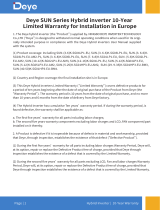2
1. TURBO ENERGY HYBRID INVERTER configuration
Step 1: Connect to the INVERTER Wi-Fi
Notice: The settings listed below are for Windows and are for reference only. If other operating
systems are used, please follow the corresponding procedures.
With an electronic device that has Wi-Fi (PC, Tablet, Smartphone…) the connection with the Wi-
Fi of the hybrid inverter (HI) is established. To do this, open the wireless network connection,
click on see the available wireless networks and select the one corresponding to the device with
which you want to connect.
The name of the network to select is AP_ Serial
number of the HI. Enter the password that appears
in the logger and select the option to connect. The
default password for hybrid inverters appears on
their label located on the bottom of the device
(example photo).
Warning: If the network to be selected is not available in the list of wireless networks, there
may be problems in the connection or in the configuration of the recorder. Wait a few minutes
to update the list or connect the logger again.










